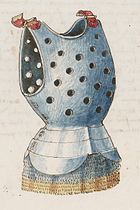Schynbalds

Schynbalds were an early experiment in plate armour for the lower leg. Schynbalds were metal plates strapped over chausses. Each schynbald was a single piece of steel that covered the front and outside of the shin. Schynbalds did not enclose the lower leg: hence, they were not true greaves. Schynbalds first appeared in the 1230s or 1250s and remained in use during the fourteenth and fifteenth centuries.[1][2]
Complete suits of armor survive only from the latter part of the schynbald era. In fifteenth century gothic armour they were strapped not to mail but to fastenings on a padded undergarment. By the early fifteenth century greaves had supplanted schynbalds in white armour. Schynbalds were essentially obsolete by the sixteenth century.
Citations
- ^ Oakeshott 1996, p. 284.
- ^ Gravett, Christopher. English Medieval Knight 1200-1300. Oxford: Osprey Pub, 2002. Print.
References
- Oakeshott, R. Ewart (1996) [1960]. The Archaeology of Weapons: Arms and Armour from Prehistory to the Age of Chivalry. Mineola, New York: Dover Publications. ISBN 978-0486292885.
{{cite book}}: Invalid|ref=harv(help)

